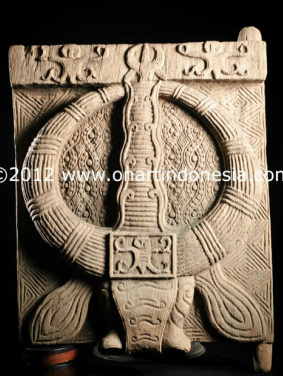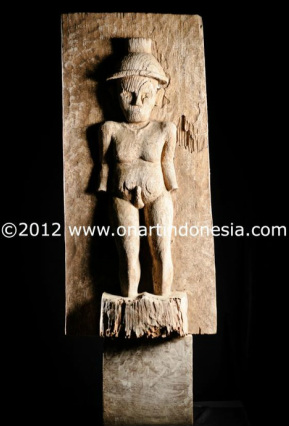central sulawesi
on the left side :
This door usually used as a door/window for the grave area in Tanah Toraja area.
The grave is located on the top of a hill, also amongst Guardians and these statues are wood human figures, known as Tao Tao, they will protect the grave.
In Toraja the people believe that their King when he dies, has a blood relationship with their God,
so they put the Kings body high up on a hill, so that the kings Spirit has easy access to heaven.
on the right side :
This door is also from Toraja, and it's usually used as a door for the royal family’s grave.
It might be more than 100 years ......
Type of Graves of Torajans
When a person dies, the body is not directly buried, but preserved by using formalin (in the past, people used certain leaves). After that, the corpse is put on the top of the house. The dead person is considered to have headache, and people still give him/her food and drink. The dead person is kept in his/her house until 2 to 5 years, it depends when is his/her family able to carry on a funeral ceremony for him/her.There are several kinds of graves:
Lemo Grave type
The family asks "to pande batu" (carving expert) to make a hole (about 3 m long and 1 m high) on stone wall. The corpse is wrapped with sarung (traditional cloth) and put inside a coffin, then the coffin is placed inside the hole. Nobles of Toraja always make "tau-tau" (a human-like statue) for dead people. Tau-tau is made similar as the dead person, including the body, appearance, clothes, and necklace. To make a statue, people have to contact "to minah" (tradition keeper, a person respected as an elderly one). Besides, they also have to check the date (time). Tao-tao for a man wears pants, and the one for a woman wears a long skirt. A person who is skillful in making tao-tao is called "to pande tao-tao". Tau-tau is still an animism belief. Common people do not make tau-tau, and after 2 - days the corpse is put into a coffin called "tongkonan". A single hole of Batu Lemo grave can be put 3-5 corpses because the size of preserved corpses can shrink to ½ m. If the hole is already full, then people need to make new a hole which are near the previous hole.
Erong Grave, Marante
The deceased person is put into a huge coffin which can contain 2-5 corpses. After that, the coffin is placed inside a cave. In Marante there can be found many human skulls and bones.
Patane Grave
It is a modern grave of Christian Torajan. The shape of the grave is a house, and it is said as the second home after a person dies. The house can contain 20-25 corpses. The corpses are placed with their coffins. The grave is also called "banua tang marambu" (house which no longer has smoke).One grave is for one family.
Ma?ne?ne? (The Ceremony of Cleaning Corpses)
Once a year, or once in every 5 or ten years Torajan people carry on a special ceremony for changing the clothes and coffins of the corpses. The cleaning day is a special day agreed by tradition keepers. People clan the corpses, change their clothes and the damaged coffins, and the scattered bnes are gathered. The clothes worn by tau-tau (statues) are also changed.
This door usually used as a door/window for the grave area in Tanah Toraja area.
The grave is located on the top of a hill, also amongst Guardians and these statues are wood human figures, known as Tao Tao, they will protect the grave.
In Toraja the people believe that their King when he dies, has a blood relationship with their God,
so they put the Kings body high up on a hill, so that the kings Spirit has easy access to heaven.
on the right side :
This door is also from Toraja, and it's usually used as a door for the royal family’s grave.
It might be more than 100 years ......
Type of Graves of Torajans
When a person dies, the body is not directly buried, but preserved by using formalin (in the past, people used certain leaves). After that, the corpse is put on the top of the house. The dead person is considered to have headache, and people still give him/her food and drink. The dead person is kept in his/her house until 2 to 5 years, it depends when is his/her family able to carry on a funeral ceremony for him/her.There are several kinds of graves:
Lemo Grave type
The family asks "to pande batu" (carving expert) to make a hole (about 3 m long and 1 m high) on stone wall. The corpse is wrapped with sarung (traditional cloth) and put inside a coffin, then the coffin is placed inside the hole. Nobles of Toraja always make "tau-tau" (a human-like statue) for dead people. Tau-tau is made similar as the dead person, including the body, appearance, clothes, and necklace. To make a statue, people have to contact "to minah" (tradition keeper, a person respected as an elderly one). Besides, they also have to check the date (time). Tao-tao for a man wears pants, and the one for a woman wears a long skirt. A person who is skillful in making tao-tao is called "to pande tao-tao". Tau-tau is still an animism belief. Common people do not make tau-tau, and after 2 - days the corpse is put into a coffin called "tongkonan". A single hole of Batu Lemo grave can be put 3-5 corpses because the size of preserved corpses can shrink to ½ m. If the hole is already full, then people need to make new a hole which are near the previous hole.
Erong Grave, Marante
The deceased person is put into a huge coffin which can contain 2-5 corpses. After that, the coffin is placed inside a cave. In Marante there can be found many human skulls and bones.
Patane Grave
It is a modern grave of Christian Torajan. The shape of the grave is a house, and it is said as the second home after a person dies. The house can contain 20-25 corpses. The corpses are placed with their coffins. The grave is also called "banua tang marambu" (house which no longer has smoke).One grave is for one family.
Ma?ne?ne? (The Ceremony of Cleaning Corpses)
Once a year, or once in every 5 or ten years Torajan people carry on a special ceremony for changing the clothes and coffins of the corpses. The cleaning day is a special day agreed by tradition keepers. People clan the corpses, change their clothes and the damaged coffins, and the scattered bnes are gathered. The clothes worn by tau-tau (statues) are also changed.
The Torajans are animists : They believe in the spirits of the dead, spirits of dead animals, the underworld . They believe that when a person dies and goes onto the next plane, they can take their possessions with them, which means that people are buried with all sorts of expensive items. In the past this led, not unexpectedly, to a serious amount of grave plundering, so the Torajans began to bury their dead in caves, hewn from the surrounding cliffs, and closed off with a door, preventing robbers from getting in, and the dead from oozing out
Read more about the funeral ceremony
Read more about the funeral ceremony
Death & Funerals
For thousands of years Southeast Asians have buried their dead with extraordinary care, laying out expansive graves filled with splendid gifts for the deceased and their glorification in the afterlife. In many animist cultures funerals continue to be the most spectacular and extravagant rites, for one of the most important tasks of the living is to ensure that the deceased are sent satisfied into the next world. To carry out these proceedings successfully the utmost consideration and the greatest art are required.
The recently deceased are the ancestors of the future, especially for members of the village elite. Enormous energy and wealth are expended on funeral rites to honour the dead in a manner appropriate to their social standing in the family and community. Lengthy and complex mortuary celebrations, sometimes held years after death, ensure a soul’s safe passage to the ancestral realm where it will oversee the activities and welfare of the living. Failure to appease a spirit can impel it to join the many other destructive spiritual beings capable of sabotaging the community’s quest for fertility and well-being.
For thousands of years Southeast Asians have buried their dead with extraordinary care, laying out expansive graves filled with splendid gifts for the deceased and their glorification in the afterlife. In many animist cultures funerals continue to be the most spectacular and extravagant rites, for one of the most important tasks of the living is to ensure that the deceased are sent satisfied into the next world. To carry out these proceedings successfully the utmost consideration and the greatest art are required.
The recently deceased are the ancestors of the future, especially for members of the village elite. Enormous energy and wealth are expended on funeral rites to honour the dead in a manner appropriate to their social standing in the family and community. Lengthy and complex mortuary celebrations, sometimes held years after death, ensure a soul’s safe passage to the ancestral realm where it will oversee the activities and welfare of the living. Failure to appease a spirit can impel it to join the many other destructive spiritual beings capable of sabotaging the community’s quest for fertility and well-being.

